

Story Elements. Page 1 of 2 What Is It?
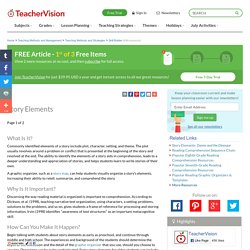
Commonly identified elements of a story include plot, character, setting, and theme. The plot usually revolves around a problem or conflict that is presented at the beginning of the story and resolved at the end. The ability to identify the elements of a story aids in comprehension, leads to a deeper understanding and appreciation of stories, and helps students learn to write stories of their own. Plotting. Digital Storytelling Process. The Narrative Writing Pack - The Narrative Writing Pack is bursting with educational posters, activities and display resources to help your children to write amazing stories!
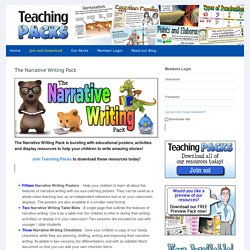
Join Teaching Packs to download these resources today! In this Teaching Pack... Fifteen Narrative Writing Posters - Help your children to learn all about the features of narrative writing with our eye-catching posters. They can be used as a whole class teaching tool, as an independent reference tool or on your classroom displays. The posters are also available in a smaller card format.Two Narrative Writing Table Mats - A single page that outlines the features of narrative writing. Click on the thumbnails below to view samples of resources from The Narrative Writing Pack. Become a member today for just £15 and you can download all of our current and future packs for a year! All payments are handled securely. Love these packs The Narrative Writing Pack Feb 02, 2015byMike O' Brien product0.3. Write a conclusion for a narrative by showing how you feel. English 50 Exercises for Story Writers. English 50 – Intro to Creative Writing: Exercises for Story Writers Basic Theory: What is a short story?
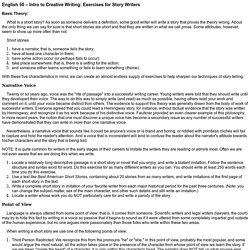
As soon as someone delivers a definition, some good writer will write a story that proves the theory wrong. About the only thing we can say for sure is that short stories are short and that they are written in what we call prose. Some attributes, however, seem to show up more often than not. Short stories have a narrator; that is, someone tells the story; have at least one character in them; have some action occur (or perhaps fails to occur); take place somewhere; that is, there is a setting for the action; and someone either learns something or fails to learn something (theme).With these five characteristics in mind, we can create an almost endless supply of exercises to help sharpen our techniques of story telling. Narrative Voice Twenty or so years ago, voice was the "rite of passage" into a successful writing career. If you've written a story in third person, try it in first. Types of Papers: Narrative/Descriptive. To write a narrative essay, you’ll need to tell a story (usually about something that happened to you) in such a way that he audience learns a lesson or gains insight.

To write a descriptive essay, you’ll need to describe a person, object, or event so vividly that the reader feels like he/she could reach out and touch it. Tips for writing effective narrative and descriptive essays: Human stories, boldly told. Interactive Narratives - The Best in Multimedia Storytelling and Multimedia Journalism. Writing Narratives. Narrative Writing Pack. Narrative Writing. Narrative Writing Resources - Empowering Writers. Empowering Writers narrative resources offer everything you need to successfully teach all types of narrative writing.

The lessons and strategies in these resources provide the “How-to” teach writing. If you are just starting out with Empowering Writers, we recommend the Comprehensive Narrative Guide (grades 2-7). This resource provides you with the methodology, teacher background, and lessons to improve writing in your classroom. In addition to the Comprehensive Narrative Guide, we recommend the Essential Guides to Writing for classrooms required to teach each genre side-by-side. These two resources address all your needs in the area of writing instruction. Narrative Pyramid. To view our printable materials, you must download the latest version of the free Adobe Acrobat software.
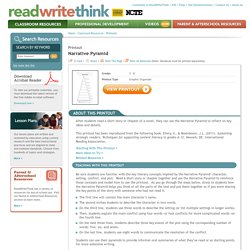
Download now Our lesson plans are written and reviewed by educators using current research and the best instructional practices and are aligned to state and national standards. Choose from hundreds of topics and strategies. Narrative Writing Lesson Plans. How to Write a Narrative Essay: 14 Steps. Edit Article Four Parts:Choosing a Good TopicWriting a DraftRevising Your EssaySample Essay Narrative essays are commonly assigned pieces of writing at different stages through school.
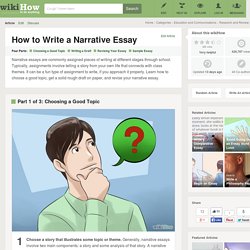
Typically, assignments involve telling a story from your own life that connects with class themes. A Pictures Worth a Thousand Words: From Image to Detailed Narrative. ReadWriteThink couldn't publish all of this great content without literacy experts to write and review for us.
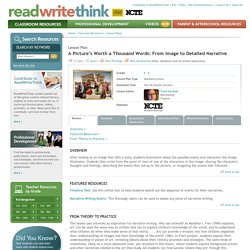
If you've got lessons plans, videos, activities, or other ideas you'd like to contribute, we'd love to hear from you. More Find the latest in professional publications, learn new techniques and strategies, and find out how you can connect with other literacy professionals. More Teacher Resources by Grade Your students can save their work with Student Interactives. More Home › Classroom Resources › Lesson Plans Lesson Plan. Narrative. Volume 23, Number 1, January 2015 Editor James Phelan Department of English The Ohio State University 164 West 17th Avenue Columbus, OH 43210-1370, USA Associate Editors Barbara Perkins, University of ToledoGeorge Perkins, Eastern Michigan University Assistant to the Editor Matthew Poland, The Ohio State University Advisory Board Frederick Luis Aldama, The Ohio State UniversityMichael Awkward, University of PennsylvaniaJanice Carlisle, Yale UniversityRobert L.
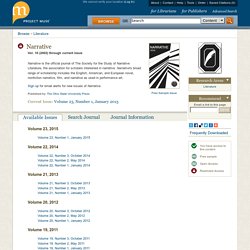
Narrative / Features of text forms / Reading / Reviewed resources / Teacher needs / English Online / English - ESOL - Literacy Online website - English - ESOL - Literacy Online. Checklist – Narrative (RTF 32KB) (RTF) Purpose The basic purpose of narrative is to entertain, to gain and hold a readers' interest.
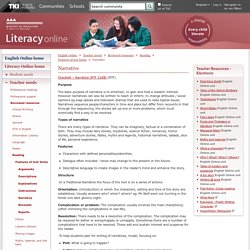
However narratives can also be written to teach or inform, to change attitudes / social opinions eg soap operas and television dramas that are used to raise topical issues. Narratives sequence people/characters in time and place but differ from recounts in that through the sequencing, the stories set up one or more problems, which must eventually find a way to be resolved.